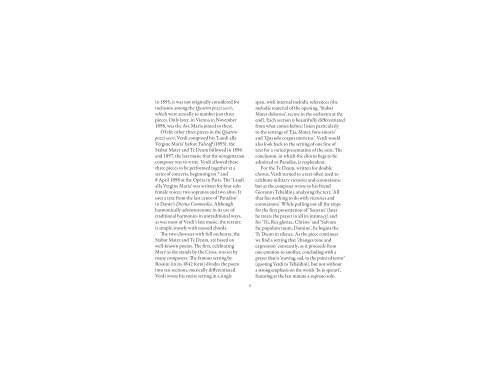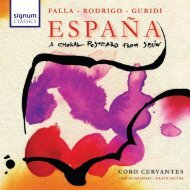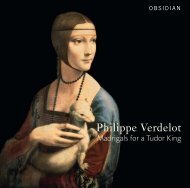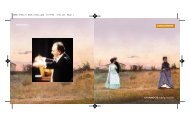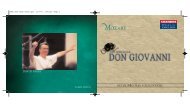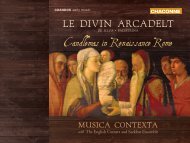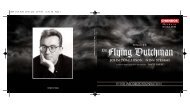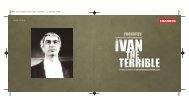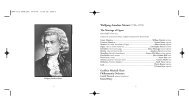Four Sacred Pieces | Hymn of the Nations - Chandos
Four Sacred Pieces | Hymn of the Nations - Chandos
Four Sacred Pieces | Hymn of the Nations - Chandos
Create successful ePaper yourself
Turn your PDF publications into a flip-book with our unique Google optimized e-Paper software.
in 1895, it was not originally considered for<br />
inclusion among <strong>the</strong> Quattro pezzi sacri,<br />
which were actually to number just three<br />
pieces. Only later, in Vienna in November<br />
1898, was <strong>the</strong> Ave Maria joined to <strong>the</strong>se.<br />
Of <strong>the</strong> o<strong>the</strong>r three pieces in <strong>the</strong> Quattro<br />
pezzi sacri, Verdi composed his ‘Laudi alla<br />
Vergine Maria’ before Falstaff (1893); <strong>the</strong><br />
Stabat Mater and Te Deum followed in 1896<br />
and 1897, <strong>the</strong> last music that <strong>the</strong> octogenarian<br />
composer was to write. Verdi allowed <strong>the</strong>se<br />
three pieces to be performed toge<strong>the</strong>r at a<br />
series <strong>of</strong> concerts, beginning on 7 and<br />
8 April 1898 at <strong>the</strong> Opéra in Paris. The ‘Laudi<br />
alla Vergine Maria’ was written for four solo<br />
female voices: two sopranos and two altos. It<br />
uses a text from <strong>the</strong> last canto <strong>of</strong> ‘Paradiso’<br />
in Dante’s Divina Commedia. Although<br />
harmonically adventuresome in its use <strong>of</strong><br />
traditional harmonies in untraditional ways,<br />
as was most <strong>of</strong> Verdi’s late music, <strong>the</strong> texture<br />
is simple, mostly with massed chords.<br />
The two choruses with full orchestra, <strong>the</strong><br />
Stabat Mater and Te Deum, are based on<br />
well-known poems. The first, celebrating<br />
Mary as she stands by <strong>the</strong> Cross, was set by<br />
many composers. The famous setting by<br />
Rossini (in its 1842 form) divides <strong>the</strong> poem<br />
into ten sections, musically differentiated.<br />
Verdi wrote his entire setting in a single<br />
span, with internal melodic references (<strong>the</strong><br />
melodic material <strong>of</strong> <strong>the</strong> opening, ‘Stabat<br />
Mater dolorosa’, recurs in <strong>the</strong> orchestra at <strong>the</strong><br />
end). Each section is beautifully differentiated<br />
from what comes before: listen particularly<br />
to <strong>the</strong> settings <strong>of</strong> ‘Eja, Mater, fons amoris’<br />
and ‘Quando corpus morietur’. Verdi would<br />
also look back to <strong>the</strong> setting <strong>of</strong> one line <strong>of</strong><br />
text for a varied presentation <strong>of</strong> <strong>the</strong> next. The<br />
conclusion, in which <strong>the</strong> chorus begs to be<br />
admitted to Paradise, is resplendent.<br />
For <strong>the</strong> Te Deum, written for double<br />
chorus, Verdi turned to a text <strong>of</strong>ten used to<br />
celebrate military victories and coronations;<br />
but as <strong>the</strong> composer wrote to his friend<br />
Giovanni Tebaldini, analysing <strong>the</strong> text, ‘All<br />
that has nothing to do with victories and<br />
coronations’. While pulling out all <strong>the</strong> stops<br />
for <strong>the</strong> first presentation <strong>of</strong> ‘Sanctus’ (later<br />
he treats <strong>the</strong> prayer in all its intimacy) and<br />
for ‘Tu, Rex gloriae, Christe’ and ‘Salvum<br />
fac populum tuum, Domine’, he begins <strong>the</strong><br />
Te Deum in silence. As <strong>the</strong> piece continues<br />
we find a setting that ‘changes tone and<br />
expression’ constantly, as it proceeds from<br />
one emotion to ano<strong>the</strong>r, concluding with a<br />
prayer that is ‘moving, sad, to <strong>the</strong> point <strong>of</strong> terror’<br />
(quoting Verdi to Tebaldini), but not without<br />
a strong emphasis on <strong>the</strong> words ‘In te speravi’,<br />
featuring at <strong>the</strong> last minute a soprano solo.<br />
9


